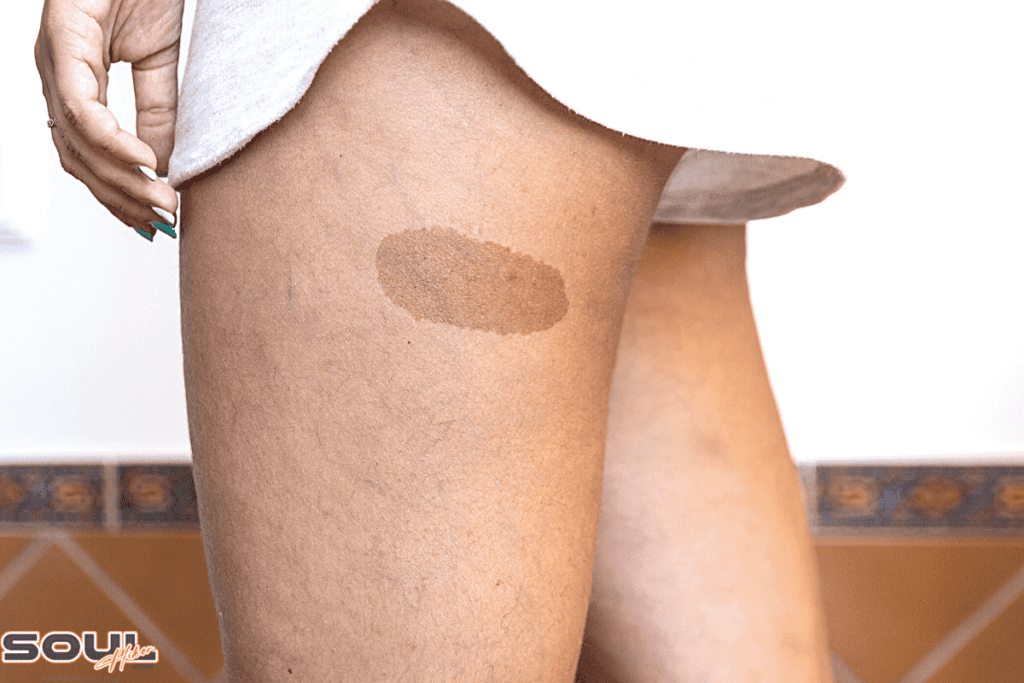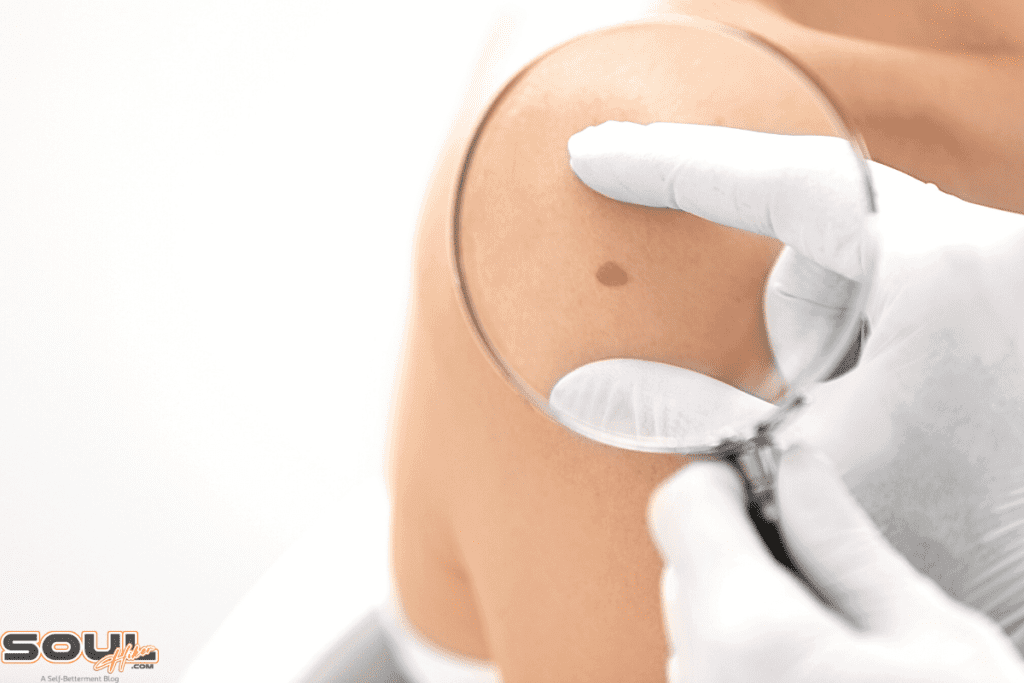Birthmarks are unique marks on the skin that one is born with, believed to possess spiritual meanings that might illuminate aspects of one’s personality, destiny, or past lives. The various types of birthmarks and their meanings range from angel kisses to port wine stains, each symbolizing different aspects of our spiritual journey. Exploring the mystical world of birthmarks and their significance can reveal what these unique skin signatures say about an individual. Below we will uncover the captivating spiritual interpretations associated with the types of birthmarks and their meanings.
Table of Contents
Types of Birthmarks and Their Spiritual Meanings
Have you ever noticed a birthmark on your body and wondered about its significance? You’re not alone. Many cultures believe birthmarks link to your personality, destiny, or even a past life. Let’s look at some common types of birthmarks and their associated spiritual meanings.
Moles and Beauty Spots
Although not technically birthmarks, moles or beauty spots often garner attention for their visibility. Spiritually, these marks are seen as symbols of luck and prosperity. Many cultures view a beauty spot on the chin as a sign of assertiveness and leadership.
Port-Wine Stains
A port-wine stain is a birthmark in which swollen blood vessels create a maroon discoloration. This type of birthmark may symbolize past life struggles. Your past life’s ordeals shape your current life, making you resilient and wise.
Café-au-Lait Spots
Café-au-lait spots are smooth, milky patches that may indicate a yearning for simplicity and a homely life. If you have one, it’s like your soul seeks peace and quiet.
These birthmark interpretations aren’t steadfast rules but reflections of various cultural beliefs. However, it’s intriguing to see how these physical markers can hold a wide array of mystical meanings. While every mark on your body is unique to you, so is its significance.
If you’re more scientifically inclined, you may see these interpretations as mere superstitions. But if you’re interested in folklore and mysticism, delving deeper into your birthmark’s meaning can be quite an interesting journey. This journey doesn’t end here, there are many more birthmarks to explore and their meanings to unravel.
What are Birthmarks?

Birthmarks are a fascinating aspect of our individuality. They’re those unique, often charming marks we notice on our skin when we’re born. So what exactly are birthmarks? Let’s delve into their general definition, their common characteristics, and the potential spiritual interpretations trailing behind them.
Definition of Birthmarks
In regards to medical definition, a birthmark is a benign irregularity on the skin that appears at birth or shortly after birth, often within the first or second month. Birthmarks can occur anywhere on the skin and vary in color, size, and shape. They’re caused by overgrowth of blood vessels, melanocytes, smooth muscle, fat, fibroblasts, or keratinocytes.
Don’t mistake a birthmark for a scar or a wound; it’s not there due to an injury of any sort. It’s simply a unique part of your body, a particular mark that you’re naturally born with.
Common Characteristics
Birthmarks are usually categorized into two main types: vascular birthmarks and pigmented birthmarks.
Vascular birthmarks, also called red birthmarks, are caused by increased blood vessels clumping together and are usually pink or red. The common types of vascular birthmarks include:
- Hemangiomas: These usually appear as a red or pink raised mark and could grow rapidly before beginning to fade.
- Port-wine stains: These are flat red or purple marks that stay the same color throughout a person’s life, often growing larger and darker.
On the other hand, pigmented birthmarks are caused by excess skin pigment cells and can be a range of colors, including brown, tan, blue, or black. The common types of pigmented birthmarks include:
- Moles (Congenital Nevus): These can be any size or shape and could be pink, tan, brown, or a color relatively similar to the person’s normal skin tone.
- Cafe-au-lait spots: These are smooth, oval birthmarks and are often light brown.
Though birthmarks typically do not cause any harm, some types might need to be checked for possible health implications. If you’ve got a birthmark that changes in appearance or causes discomfort, it’s best to contact a healthcare provider.
In the spiritual realm, birthmarks go beyond mere skin deep. They’re believed to carry significance concerning personality, destiny, or past life. Each mark represents a unique symbol with its own mysterious meaning.
Such potent signs can reveal astonishing insights about your character, just waiting to be unraveled in the spiritual journey of self-discovery. So you see, birthmarks can become a path to understanding oneself better.
Physical Causes of Birthmarks
Despite the spiritual significance associated with birthmarks, they don’t appear on your skin due to magic or cosmic influences. Instead, birthmarks tend to result from physical and biological factors.
Genetic Factors

Genes contribute significantly to the formation of birthmarks. Some birthmarks, particularly pigmented ones, are thought to be influenced by genetic factors, making them more likely to be passed down from parent to child.
For example, cafe-au-lait spots are influenced by genes, explaining why they’re often seen across generations within a family. Additionally, certain syndromes, such as Neurofibromatosis, are associated with the presence of multiple birthmarks and are known to be inherited.
However, it’s worth noting that not all birthmarks are hereditary. There are cases where a child has a birthmark, but there’s no family history of it. The unpredictability and randomness of birthmarks add to the intrigue and mystique surrounding them.
Environmental Factors
Moving away from genetics, external circumstances have a role to play as well. Environmental factors, specifically conditions in a mother’s womb during pregnancy, can lead to the formation of vascular birthmarks.
One theory suggests that a tiny piece of the placenta gets lodged in the developing baby’s skin. This piece continues to grow and develop into what we know as a birthmark.
In other instances, a minor hiccup in embryonic growth can result in excess blood vessels or skin pigmentation cells, leading to either vascular or pigmented birthmarks. The remaining area of mystery, however, is why specific environmental factors lead to certain types of birthmarks.
Despite the progress in understanding birthmarks’ physical causes, they continue to fascinate with their unpredictability and uniqueness.
Birthmark Classification Based on Types
Birthmarks primarily get classified into Pigmented Birthmarks, Vascular Birthmarks, Congenital Moles, and Stork Bites. Here’s what you need to know about these types.
Pigmented Birthmarks
These are typically colored, caused by excess skin pigment cells. Examples include moles, café-au-lait spots, and Mongolian spots. The colors can range from light brown to black in moles, light brown in café-au-lait spots, and blue-gray in Mongolian spots. They could be flat or raised, and the size often varies from one person to another.
Vascular Birthmarks
Vascular birthmarks occur when blood vessels don’t form correctly, either because too many of them form or because they’re wider than usual. For instance, you might be familiar with the term “port-wine stains”, or you might’ve heard of “strawberry marks”. These are common types of vascular birthmarks. Their appearance typically varies from pink to purple marks.
Congenital Moles
Also known as congenital nevi, these types of birthmarks are usually present from birth. They ordinarily appear as light brown to black patches of skin and vary greatly in size. Interestingly, the larger the congenital mole is, the higher the risk of it developing into skin cancer, making these birthmarks something to keep an eye on.
Stork Bites
Also referred to as salmon patches, these marks are bright red birthmarks that often appear at the back of the neck. They’re usually small and may not be noticeable when your child is born.
However, when your baby cries or gets overheated, these marks might become more apparent. Most stork bites fade away by the time a child turns two, but some may persist into adulthood.
By understanding these different types of birthmarks, you’ll be better informed on what might be a cause for concern and when it’s simply a unique feature adding to your or your child’s individuality.
Spiritual Meanings of Birthmarks
Birthmarks aren’t just physical indicators on your skin. They’ve been interpreted by various cultures around the world as carrying certain messages or spiritual significance.
Ancient Beliefs and Traditions
Ancient civilizations held strong beliefs regarding birthmarks. They believed that these marks were not random, but rather, carried some form of divine message.
For instance, Greek and Roman cultures view birthmarks as symbols reflecting the emotional state of the mother during pregnancy. If the mother experienced a strong fear or wish, it’s believed she’d imprint a birthmark onto her unborn child.
Moreover, some of Africa’s tribal cultures believe birthmarks are ancestral birthrights. They serve as a sign that the newborn is a reincarnation of a deceased family member.
Birthmarks and Reincarnation
Birthmarks have been tied to the concept of reincarnation, mainly in Asian countries. According to certain Buddhist and Hindu beliefs, birthmarks indicate the site of fatal wounds suffered in past lives.
Dr. Ian Stevenson, a psychiatrist at the University of Virginia, meticulously documented multiple children’s claims about their past lives. He published his findings in the book “Reincarnation and Biology: A Contribution to the Etiology of Birthmarks and Birth Defects”. In his study, he found a correlation between birthmarks and the manner of death in previous lives as described by the children.
Birthmarks as Symbols of Destiny
Finally, birthmarks have been viewed as foretelling a person’s destiny. In European cultures, a birthmark on the face signifies that the person is destined for greatness. On the other hand, a birthmark on the left foot might imply hardship and struggle in life.
On a more positive note, Chinese folklore believes having a birthmark on your arm means you’ll come into wealth. If on your back, then it’s believed you’ll achieve fame.
One aspect that remains constant among these different beliefs and interpretations, is the inherent mysticism surrounding birthmarks. You’re encouraged to delve deeper, explore these narratives and draw your interpretations about the spiritual significance of birthmarks.
Remember, every birthmark is unique just like each individual’s journey in life.
Understanding Your Birthmark’s Spiritual Meaning
These unique, often pigmented spots on our bodies, hold a special place in our lives and discussions about spirituality. Throughout history, different cultures have imparted specific meanings and symbolism to these marks. So, it’s paramount to understand your birthmark’s spiritual meaning from both a global and personal perspective.
Reflection and Self-Awareness
You might be wondering, “How do I understand my birthmark’s spiritual meaning?” Well, a great place to start is by taking a long, introspective look at your birthmark. Consider its location, size, shape, and color.
Each of these elements could potentially hold spiritual significance based on historical interpretations and beliefs. Also, think about the emotions or thoughts that arise when you contemplate your birthmark.
- Do you feel a sense of connection to something larger than yourself?
- Do certain images, thoughts, or feelings surface consistently?
- Can you identify a recurring theme or message?
Such reflection can lead to a deeper level of self-awareness, fostering a sense of connection and understanding. Cultivating self-awareness can also help in accepting and appreciating your birthmark in the context of your own personal spiritual journey.
Seeking Spiritual Guidance
Of course, self-reflection is just part of understanding the spiritual significance of your birthmark, as seeking spiritual guidance can also be advantageous. Don’t be afraid to engage in conversations with others about your birthmark and its possible meanings.
Open and honest dialogue can foster understanding, awareness, and acceptance of these unique individual marks. Sometimes, enlightenment can come from the most unexpected places.
There’s no one-size-fits-all when it comes to interpreting the spiritual significance of your birthmark. Remember, the most important thing is to explore these narratives and derive your own, personal interpretations. S
